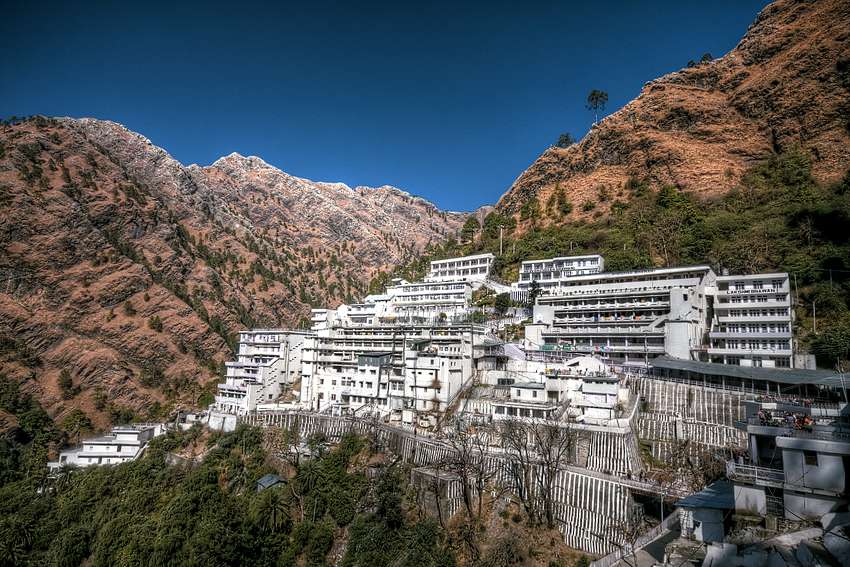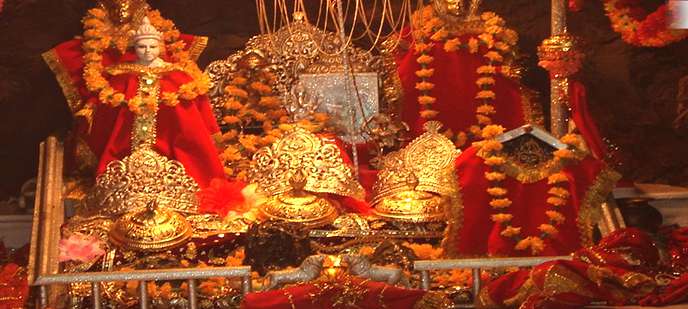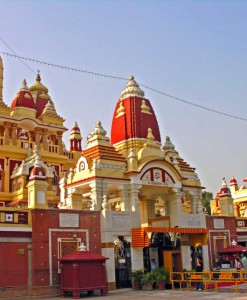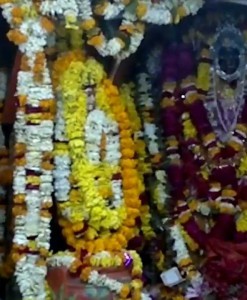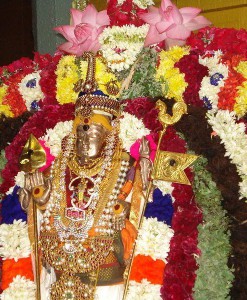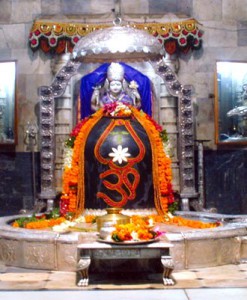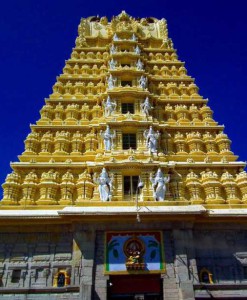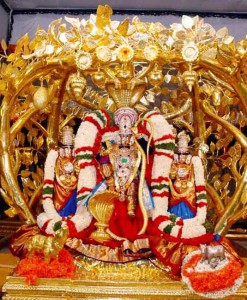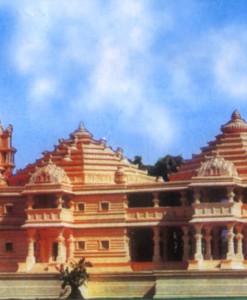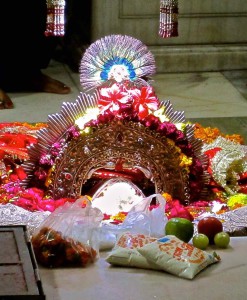No products in the cart.
Mata Vaishno Devi Mandir is a holy pilgrimage destination for the Hindus. It is located at a height of 5300 feet on the holy Trikuta Hills of the Shivalik Hill Range, 12 km away from Katra in the state of Jammu and Kashmir, India. It is one of the 108 Shaktipeeths. The Holy cave is 13 Kms from the Base Camp Katra.
The Holy Cave of the Mother is situated at an altitude of 5200 ft. The Yatris have to undertake a trek of nearly 12 km from the base camp at Katra. At the culmination of their pilgrimage, the yatries are blessed with the Darshans of the Mother Goddess inside the Sanctum Sanctorum- the Holy Cave. These Darshans are in the shape of three natural rock formations called the Pindies. There are no statues or idols inside the Cave.
Vaishnodevi pilgrims (yatris) visit the temple every year and it is the second most visited religious shrine in India, after Tirumala Venkateswara Temple. Inside the Vaishno Devi temple, middle one represents Goddess Lakshmi, right statue represents Goddess Kali and left one represents Goddess Saraswati. It is one of the 52 Shaktipeethas. Some followers believes that the skull of Mata Sati fell in this area, yet other believes that her right hand, which holds the Abhaya Hasta (the gesture of succour), had fallen there.
Mata is form of Shakti or Parvati. She is very beautiful and is dressed in red. Her eight arms hold trident, bow, arrow, lotus, mace and sword and abhaya gesture. She rides on tiger. Vaishno Devi, also known as Mata Rani and Vaishnavi, is a manifestation of the Hindu Mother Goddess or Durga. The words “maa” and “mata” are commonly used in India for “mother”, and thus are often used in connection with Vaishno Devi.
There are three Pindis at the temple representing three Goddesses- namely Maha Saraswati, Maha Lakshmi and Maha Kali. Picturesque surroundings and the verdant, green surroundings keep company to tourists and pilgrims on their journey to the Vaishno Devi temple.
As in the case of all holy places, there are several legends connected with the shrine of Mata Vaishno Devi.
There are several other legends connected with the place. A popular one amongst them is the legend of Shridhar’s vision. According to the legend, Sridhar was a poor Brahmin who lived in village Hansali near Katra about seven hundred years ago. Sridhar was had no child and therefore, he ardently worshiped the goddess hoping to get a child of his own. As a part of his daily ritual he performed ‘Kanya-Pujan’ to please the goddess. One day while Sridhar was performing the ‘Kanya-Pujan’ a girl who looked did not seem from his village appeared and told him to hold a Bhandara (community meal) for all the villagers the next day. The girl assured him that by performing the same all his cherished dreams shall come true. Saying so, the mysterious girl disappeared. Sridhar was mystified by the strange appearance of the unknown girl and decided to do as asked for by the girl inspite of the fact that he was a very poor Brahmin. He invited not only every villager for the Bhandara but also Guru Gorakhnath and his disciples whom it was believed that not even Lord Indra had been able to satisfy. When the fateful day dawned, the worried Sridhar was relieved to see the strange girl again, who instructed him to ask each and every invitee to get seated in the small little hut of Sridhar. To the utter disbelief of Sridhar as the invitees started to take their place inside the small hut, there always seemed to be some space for few more people. After every one was seated the girl herself began to serve the food of their choice to everyone. Seated among the guests was a disciple of guru Gorakhnath named Bhairon Nath who on his turn asked the holy girl to serve him meat and wine. When the girl refused to provide him these items in the house of a Brahamin, Bhairon Nath tried to grab her hand. The girl immediately with her powers disappeared from the scene and proceeded to the mighty Trikuta Hills. Bhairon Nath in order ascertains the reality of this mysterious girl and to put to test her powers, started following her. The holy girl passed through Banganga, Charan-Paduka, Ardhkwari, and then reached the holiest of the holy cave situated amidst the folds of the Trikuta-hills. When Bhairon Nath continued to follow her despite the girl (who was the goddess) trying to avoid a confrontation,she was compelled to kill him. Bhairon Nath met his ultimate fate when the goddess, just outside the mouth of the cave, beheaded him. The severed head of the Bhairon Nath fell with a force at a distant hilltop. The Bhairon Nath upon death realised the futility of his mission and asked her to forgive him. The almighty ‘Mata’ had mercy on Bhairon and gave him a boon that every devotee of the goddess would have to receive his Darshans after receiving darshan of the goddess and only then would the yatra of a devotee be considered complete.
In the meantime, Sridhar was depressed by the whole episode and in a fit of despair renounced food and started fasting. One day he had a dream of the same girl who told him that she was Vaishno Devi and showed him the vision of her cave and also blessed him with the boon of four sons. Sridhar, happy once again, set out in search of the cave, and after finding it he decided to spend the rest of his life at the foot of this cave in worship of the deity. Soon the fame of the holy cave spread, and the devotees began to flock it to pay their homage to the mighty Goddess.
Mata Vaishno Devi Temple, Katra
The shrine of Mata Vaishno Devi was discovered about 700 years back by Pandit Shridhar. According to the popular belief, Mata once helped in organizing a Bhandaara at Shridhar’s place. But, she had to leave the place to escape Bhairon Nath. As Mata left the place, Shridhar started giving up food in grief and started praying for Mata Vaishno Devi.
Mata Vaishno Devi came in his dreams and asked him to search for her at the cave in the Trikuta Mountain. This led to the discovery of the holy cave. Shridhar found three head atop a rock, which are currently known as the Holy Pindies.
Finalization on the purchase of the property was done on December 15th 1987. The executive committee then proceeded to plan for the designing and subsequent procurement of the work permit. Application for the permit was made on October 19th 1990, and the formal work permit was issued on April 9, 1991. On May 12, 1991 we had the Bhumi Puja on the grounds of the temple which was also the first official function. On May 27, 1991 work on the site commenced. Many changes have been made.
The opening ceremony of this temple was held on November 3, 1991. Ex-President Dr. S.C. Vohra along with the members of the ex-Executive Committee extends his appreciation and thanks to the community; on this auspicious day of opening of “Vaishnu-Devi Temple”, an everlasting sign of heritage, in the town of Oakville.
Navratra Festival is celebrated every year in the base camp of Sri Mata Vaishno Devi, Katra. On this auspicious occasion entire Katra town is decorated tastefully and people from the region participate in large numbers.
The Navratra Festival starts with the formal inauguration ceremony. On the first day, after the prayers are offered to Goddess Mata Vaishno Devi, flowers are showered from a helicopter (at times) to mark the beginning of the celebrations. The entire cultural heritage of the region is on display everywhere. One can see the locals dressed up in the traditional attire symbolizing the rich Dogra culture.
Special Rituals/ Prarthana performed in temple
The ‘Aarti’ of the Goddess is performed twice a day first time in the morning before the sunrise and second time in the evening after the sunset, during which only the Pujaris, Pandits and security staff besides senior most functionaries of the Board at Bhawan are allowed inside the sanctum- sanctorum.
The procedure of ‘Aarti’ is a very sacred and lengthy one. The Pujaris perform ‘Aarti’ before the deity first inside the sanctum- sanctorum and then outside the cave. Before the commencement of ‘Aarti’, the Pujaris perform ‘Aatma pujan’ i.e. self-purification. Then the Goddess is bathed in water, milk, ghee (Clarified butter), honey and sugar, which is called Panchamrita Puja. Thereafter the goddess is dressed-up in a saree, chola and chunari and adorned with ornaments. The whole process takes place along with the enchantment of various shlokas and Mantras. Thereafter Tilak (sacred mark) is placed on the forehead of the deity and Naivedya (prasad) is offered to her.
It is a common faith among the folk that Goddess-Vaishno sends a ‘Call’ to her devotees and that once a person receives it, wherever he or she is, marches towards the holy shrine of the great Goddess. A supernatural power seems to draw them through the mountain and they climb up those great heights step by step, chanting ‘Prem se bolo, Jai Mata Di’.
Pilgrims must remember to leave behind any leather shoes or accessories as these are forbidden at Vaishno Devi.
Daily Puja Schedule
Monday to Friday (7AM to 1PM) and (4PM to 9PM)
Saturday, Long weekend Or Civic Holiday (7AM to 9PM)
Sunday (7AM to 8PM)
Mata Vaishno Devi temple can be reached from Katra. Katra is a small but bustling town around 45 km. from Jammu. From Katra, after getting the ‘Yatra Parchi’ (Journey Slip) at Banganga point for darshan, devotees can proceed to the Bhavan.
If you want to make a travel to this place you can choose any of the following options:
By Bus
Jammu and Kashmir State Road Transport Corporation buses operate to and from Jammu to Katra at regular intervals. Air-conditioned private deluxe buses and taxis are also available from Jammu to Katra.
By Air
Located at a distance of 50 kilometres, the Jammu airport is the nearest to Katra. Jammu is well-connected with major airports in India. It’s easy to get a cab from the Jammu airport to Katra as regular taxi and cab services are available.
By Train
The nearest railway station from Katra is the Udhampur railway station. Taxi and cab services are available from the railway station to Katra.

